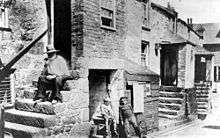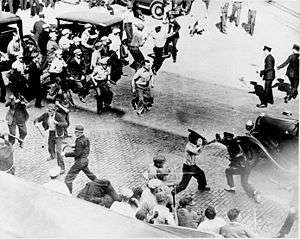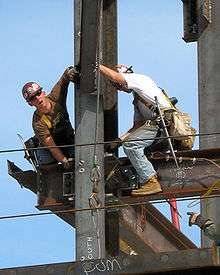Working class
The working class (or labouring class) comprises those engaged in waged or salaried labour, especially in manual-labour occupations and industrial work.[1][2] Working-class occupations (see also "Designation of workers by collar color") include blue-collar jobs, some white-collar jobs, and most pink-collar jobs. Members of the working class rely exclusively upon earnings from wage labour; thus, according to more inclusive definitions, the category can include almost all of the working population of industrialized economies, as well as those employed in the urban areas (cities, towns, villages) of non-industrialized economies or in the rural workforce.
Definitions
As with many terms describing social class, working class is defined and used in many different ways. The most general definition, used by many socialists, is that the working class includes all those who have (more or less, they do not own e.g a factory) nothing to sell but their labour. These people used to be referred to as the proletariat, but that definition has gone out of fashion. In that sense, the working class today includes both white and blue-collar workers, manual and mental workers of all types, excluding only individuals who derive their livelihood from business ownership and the labour of others.[3]
When used non-academically in the United States, however, it often refers to a section of society dependent on physical labour, especially when compensated with an hourly wage (for certain types of science, as well as journalistic or political analysis). For example, the working class is loosely defined as those without college degrees.[4] Working-class occupations are then categorized into four groups: unskilled labourers, artisans, outworkers, and factory workers.[5]
A common alternative, sometimes used in sociology, is to define class by income levels.[6] When this approach is used, the working class can be contrasted with a so-called middle class on the basis of differential terms of access to economic resources, education, cultural interests, and other goods and services. The cut-off between working class and middle class here might mean the line where a population has discretionary income, rather than finances for basic needs and essentials (for example, on fashion versus merely nutrition and shelter).
Some researchers have suggested that working-class status should be defined subjectively as self-identification with the working-class group.[7] This subjective approach allows people, rather than researchers, to define their own "subjective" and "perceived" social class.
History and growth

In feudal Europe, the working class as such did not exist in large numbers. Instead, most people were part of the labouring class, a group made up of different professions, trades and occupations. A lawyer, craftsman and peasant were all considered to be part of the same social unit, a third estate of people who were neither aristocrats nor church officials. Similar hierarchies existed outside Europe in other pre-industrial societies. The social position of these labouring classes was viewed as ordained by natural law and common religious belief. This social position was contested, particularly by peasants, for example during the German Peasants' War.[8]
In the late 18th century, under the influence of the Enlightenment, European society was in a state of change, and this change could not be reconciled with the idea of a changeless god-created social order. Wealthy members of these societies created ideologies which blamed many of the problems of working-class people on their morals and ethics (i.e. excessive consumption of alcohol, perceived laziness and inability to save money). In The Making of the English Working Class, E. P. Thompson argues that the English working class was present at its own creation, and seeks to describe the transformation of pre-modern labouring classes into a modern, politically self-conscious, working class.[8][9]
Starting around 1917, a number of countries became ruled ostensibly in the interests of the working class (see Soviet working class). Some historians have noted that a key change in these Soviet-style societies has been a massive a new type of proletarianization, often effected by the administratively achieved forced displacement of peasants and rural workers. Since then, four major industrial states have turned towards semi-market-based governance (China, Laos, Vietnam, Cuba), and one state has turned inwards into an increasing cycle of poverty and brutalization (North Korea). Other states of this sort have collapsed (such as the Soviet Union).[10]
Since 1960, large-scale proletarianization and enclosure of commons has occurred in the third world, generating new working classes. Additionally, countries such as India have been slowly undergoing social change, expanding the size of the urban working class.[11]
Marxist definition: the proletariat

Karl Marx defined the working class or proletariat as individuals who sell their labour power for wages and who do not own the means of production. He argued that they were responsible for creating the wealth of a society. He asserted that the working class physically build bridges, craft furniture, grow food, and nurse children, but do not own land, or factories.[12]
A sub-section of the proletariat, the lumpenproletariat (rag-proletariat), are the extremely poor and unemployed, such as day labourers and homeless people. Marx considered them to be devoid of class consciousness.
In The Communist Manifesto, Karl Marx and Friedrich Engels argued that it was the destiny of the working class to displace the capitalist system, with the dictatorship of the proletariat (the rule of the many, as opposed to the "dictatorship of the bourgeoisie"), abolishing the social relationships underpinning the class system and then developing into a future communist society in which "the free development of each is the condition for the free development of all." The Communist Manifesto was a response to Adam Smith's pro capitalist text The Wealth of Nations[13] (published in 1776). Some issues in Marxist arguments about working-class membership have included:
- The class status of people in a temporary or permanent position of unemployment.
- The class status of domestic labour, particularly the children (see child labour), and also traditionally the wives of male workers, as some spouses do not themselves work in paying jobs outside the home.
- Whether workers can be considered working class if they own personal property or small amounts of stock ownership.
- The relationships among peasants, rural smallholders, and the working class.
- The extent to which non-class group identities and politics (race, gender, etc.) can obviate or substitute for working-class membership in Enlightenment projects, where working-class membership is prohibitively contradictory or obfuscated.
Possible responses to some of these issues are:
- Unemployed workers are proletariat.
- Class for dependents is determined by the primary income earner.
- Personal property is argued to be different from private property. For example, the proletariat can own automobiles; this is personal property.
- The self-employed worker may be a member of the petite bourgeoisie (for example, a small store owner who controls little capital), or a de facto member of the proletariat (for example, a contract worker whose income may be relatively high, but is precarious and tied to the need to sell one's labour on the labour market).
In general, in Marxist terms wage labourers and those dependent on the welfare state are working class, and those who live on accumulated capital are not. This broad dichotomy defines the class struggle. Different groups and individuals may at any given time be on one side or the other. Such contradictions of interests and identity within individuals' lives and within communities can effectively undermine the ability of the working class to act in solidarity to reduce exploitation, inequality, and the role of ownership in determining people's life chances, work conditions, and political power.
See also
- Apprentice
- Blue collar
- Embourgeoisement thesis
- False consciousness
- Globalization
- Household income in the United States
- Industrial novel
- Labour movement
- Living wage
- Minimum wage
- Proletarian literature
- Proletarian novel
- Reserve army of labour
- Seebohm Rowntree, English sociological researcher
- Social mobility
- Trade union
- Vocational education
- Wage slavery
- Working class in the United States
- Working-class culture
References
Footnotes
- "WORKING CLASS | definition in the Cambridge English Dictionary". dictionary.cambridge.org. Retrieved 1 May 2019.
- "working class". Oxford Dictionaries. Retrieved 8 May 2014.
- McKibbin 2000, p. 164.
- Edsall, Thomas B. (17 June 2012). "Canaries in the Coal Mine". Campaign Stops. The New York Times. Retrieved 18 June 2012.
- Doob 2013.
- Linkon 1999, p. 4.
- Rubin et al. 2014.
- Abendroth 1973.
- "Thompson: The Making of the English Working Class — Faculty of History". www.hist.cam.ac.uk. Retrieved 1 May 2019.
- Kuromiya 1990, p. 87.
- Gutkind 1988.
- Lebowitz 2016.
- "The Wealth of Nations". Adam Smith Institute. Retrieved 1 May 2019.
Bibliography
- Abendroth, Wolfgang (1973). A Short History of the European Working Class.CS1 maint: ref=harv (link)
- Doob, Christopher B. (2013). Social Inequality and Social Stratification in US Society. Upper Saddle River, New Jersey: Pearson Education. ISBN 978-0-205-79241-2.CS1 maint: ref=harv (link)
- Gutkind, Peter C. W., ed. (1988). Third Worlds Workers: Comparative International Labour Studies. International Studies in Sociology and Social Anthropology. 49. Leiden, Netherlands: E.J. Brill. ISBN 978-90-04-08788-0. ISSN 0074-8684.CS1 maint: ref=harv (link)
- Kuromiya, Hiroaki (1990). Stalin's Industrial Revolution: Politics and Workers, 1928–1931.CS1 maint: ref=harv (link)
- Lebowitz, Michael A. (2016). Beyond Capital: Marx's Political Economy of the Working Class.CS1 maint: ref=harv (link)
- Linkon, Sherry Lee (1999). "Introduction". In Linkon, Sherry Lee (ed.). Teaching Working Class. Amherst, Massachusetts: University of Massachusetts Press. pp. 1ff. ISBN 978-1-55849-188-5.CS1 maint: ref=harv (link)
- McKibbin, Ross (2000). Classes and Cultures: England, 1918–1951.CS1 maint: ref=harv (link)
- Rubin, Mark; Denson, Nida; Kilpatrick, Sue; Matthews, Kelly E.; Stehlik, Tom; Zyngier, David (2014). "'I Am Working-Class': Subjective Self-Definition as a Missing Measure of Social Class and Socioeconomic Status in Higher Education Research" (PDF). Educational Researcher. 43 (4): 196–200. doi:10.3102/0013189X14528373. ISSN 1935-102X.CS1 maint: ref=harv (link)
Further reading
- Benson, John (2003). The Working Class in Britain, 1850–1939. London: I.B. Tauris. ISBN 978-1-86064-902-8.
- Blackledge, Paul (2011). "Why Workers Can Change the World". Socialist Review. No. 364. London. Retrieved 20 November 2018.
- Connell, Raewyn; Irving, Terry (1980). Class Structure in Australian History. Melbourne: Longman Cheshire.CS1 maint: ref=harv (link)
- Engels, Friedrich (1968). The Condition of the Working Class in England. Translated by Henderson, W. O.; Chaloner, W. H. Stanford, California: Stanford University Press. ISBN 978-0-8047-0634-6.
- Miles, Andrew; Savage, Mike (1994). The Remaking of the British Working Class, 1840–1940. London: Routledge. ISBN 978-1-134-90681-9.
- Moran, William (2002). Belles of New England: The Women of the Textile Mills and the Families Whose Wealth They Wove. New York: Thomas Dunne Books. ISBN 978-0-312-30183-5.
- Raine, April Janise (2011). "Lifestyles of the Not So Rich and Famous: Ideological Shifts in Popular Culture, Reagan-Era Sitcoms and Portrayals of the Working Class". McNair Scholars Research Journal. 7 (1): 63–78. Retrieved 20 November 2018.
- Rose, Jonathan (2010). The Intellectual Life of the British Working Classes (2nd ed.). New Haven, Connecticut: Yale University Press. ISBN 978-0-300-15365-1.
- Rubin, Lillian B. (1976). Worlds of Pain: Life in the Working Class Family. New York: Basic Books. ISBN 978-0-465-09724-1.
- Rowntree, Seebohm (2000) [1901]. Poverty: A Study of Town Life. Macmillan and Co. ISBN 1-86134-202-0.
- Sheehan, Steven T. (2010). "'Pow! Right in the Kisser': Ralph Kramden, Jackie Gleason, and the Emergence of the Frustrated Working‐Class Man". Journal of Popular Culture. 43 (3): 564–582. doi:10.1111/j.1540-5931.2010.00758.x. ISSN 1540-5931.
- Shipler, David K. (2004). The Working Poor: Invisible in America. New York: Knopf. ISBN 978-0-375-40890-8.
- Skeggs, Beverley (2004). Class, Self, Culture. London: Routledge. ISBN 978-0-415-30086-5.
- Thompson, E. P. (1968). The Making of the English Working Class (rev. ed.). Harmondsworth, England: Penguin Books.
- Turner, Katherine Leonard (2014). How the Other Half Ate: A History of Working-Class Meals at the Turn of the Century. Berkeley, California: University of California Press. ISBN 978-0-520-27758-8.
- Zweig, Michael (2001). Working Class Majority: America's Best Kept Secret. Ithaca, New York: Cornell University Press. ISBN 978-0-8014-8727-9.
External links
| Wikiquote has quotations related to: Working class |
| Look up working class in Wiktionary, the free dictionary. |
- The Center for Working-Class Studies at Youngstown State University
- International Labor and Working-Class History Journal
- Images of the working class between 1840 and 1945 from the McCord Museum's online collection
- BBC Archive collection of TV & Radio programmes about Working Class Britain
- Caring too much. That's the curse of the working classes. David Graeber for The Guardian. March 2014.
- US millennials feel more working class than any other generation. The Guardian. March 2016.
